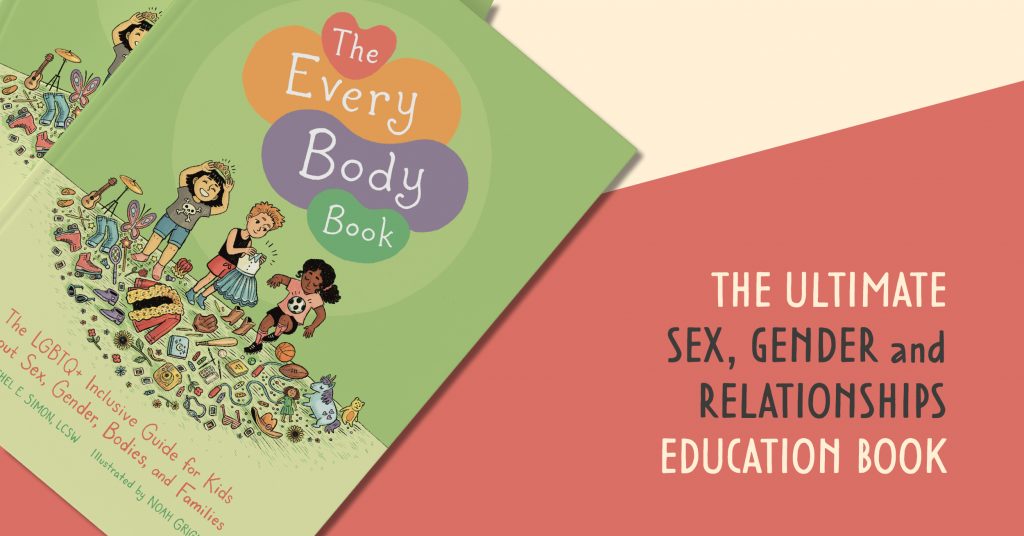The Every Body Book by Rachel Simon provides an inclusive guide to sex education.

Can you briefly outline your background?
I’m a psychotherapist and sexuality educator, and I specialize in gender therapy for youth, teens, and young adults. I’m from the DC area but have lived and worked in Philadelphia for 8 years. I am a licensed clinical social worker and psychotherapist who offers therapy, gender and sexuality education, and consulting to youth, parents, families, educational faculty, professional organizations, and health professionals.
I received both Master’s degrees from Widener University, and received my BA in Psychology and LGBT Studies from the University of Maryland. I’ve provided training and consultation on gender, sex, and LGBTQ issues for groups in Pennsylvania, New Jersey, Maryland, and D.C. I currently run my private psychotherapy practice in Philadelphia, specializing in queer and transgender youth and young adults. Most recently, I became an author with the sexuality education book for children, The Every Body Book: The LGBTQ+ Inclusive Guide for Kids About Sex, Gender, Bodies, and Families.
What was the inspiration behind The Every Body Book?
In my practice, I work with youth and families who are often becoming well versed in having conversations about gender. As their children began asking more questions about sex, sexuality, puberty, and bodies, parents wanted some resources that could facilitate more conversations and help answer those questions. Unfortunately, the resources that do exist are often inaccessible and exclusive to gender expansive youth, not to mention often include a limited representation of the diversity of bodies and families. I wanted parents to be able to have an inclusive, comprehensive book that affirms and celebrates the diversity of people and families, and I didn’t see one that existed- so I wrote one! I’m hopeful that parents, teachers, and caregivers can finally have a resource that includes all kids and families, instead of having to navigate resources that don’t apply to their realities.
How can teachers and other educators, especially parents currently tackling home schooling, use The Every Body Book in an educational setting?
The Every Body Book is made to be read together and alone, depending on the questions children are having about sex. The book is medically accurate without being overly clinical, and that was an intentional choice- educators and parents can use this as a textbook for the all-important school subject of sex ed! Sex talks (plural!) should be had early and often- research shows that kids and teens who have these conversations regularly with parents and caregivers end up taking fewer risks with their sexual health. Depending on the age of the kid, and their curiosity for the subject matter, parents and educators can take the book a chapter at a time, or in bigger parts!
One way to assess for readiness is to asks kids questions about their questions. “What have you heard about that” and “what do you already know about that” are really good clarifying questions so that we don’t overload kids’ brains with too much, when all they were asking about was something really specific.
Sex ed can be an awkward subject to tackle. Do you have any advice for parents and teachers struggling to get over that awkwardness?
Awkwardness can be a super normal part of talking with kids about sex. Adults often have their own feelings that can come up around these topics and make the conversations even more daunting. The awkwardness is worth pushing through, because we want to show our kids that these topics are worth continuing to bring up, and that their sexual health matters to us. Remember that nonverbals are important here- even if you can’t help but blush or stammer, make sure you verbally affirm the questions kids have- “I’m glad you asked”, “Let’s talk about it”, and “This is so important”. It also helps to use every day opportunities to keep the conversations going- what we’re seeing on the news and tv shows, what they’re hearing at school, what’s going on in the community- these are all places we might talk about consent, sexualization, heteronormativity, and more!
What kids often want from conversations about sex is for parents and educators to approach them as conversations instead of lectures. It might be useful to share your values as a parent, but as an offering or example instead of a directive. The goal is to empower kids to be able to think about their own value systems, how they might be similar and different than others, and how to think critically and come to their own conclusions. This can be done from a younger age than we think!
What are some important lessons people, both adults and young people, can take away from your book?
All bodies are good bodies. There is no such thing as “normal”. There are lots of ways to have a family; some will be different than yours. Gender and sex are different; neither are binary. There are no right ways of being a boy, being a girl, being both, or being neither. We can and should be inclusive with our language. Everyone deserves to have their bodies, their boundaries, and their choices respected. Not everyone who gives birth is a woman or a mom. Representation matters! Young people are the experts of their own identities. And finally, the intersections of identity matter to people’s experiences- Black LGBTQ+ people have different experiences than white LGBTQ+ people, disabled people deserve agency and autonomy, religious community can impact sexual values, and the way we advocate for people will look different if we keep things like this in mind.
Are there any additional resources you would recommend for parents and teachers looking to further their education or make their space more inclusive?
Absolutely! Resources I suggest are: